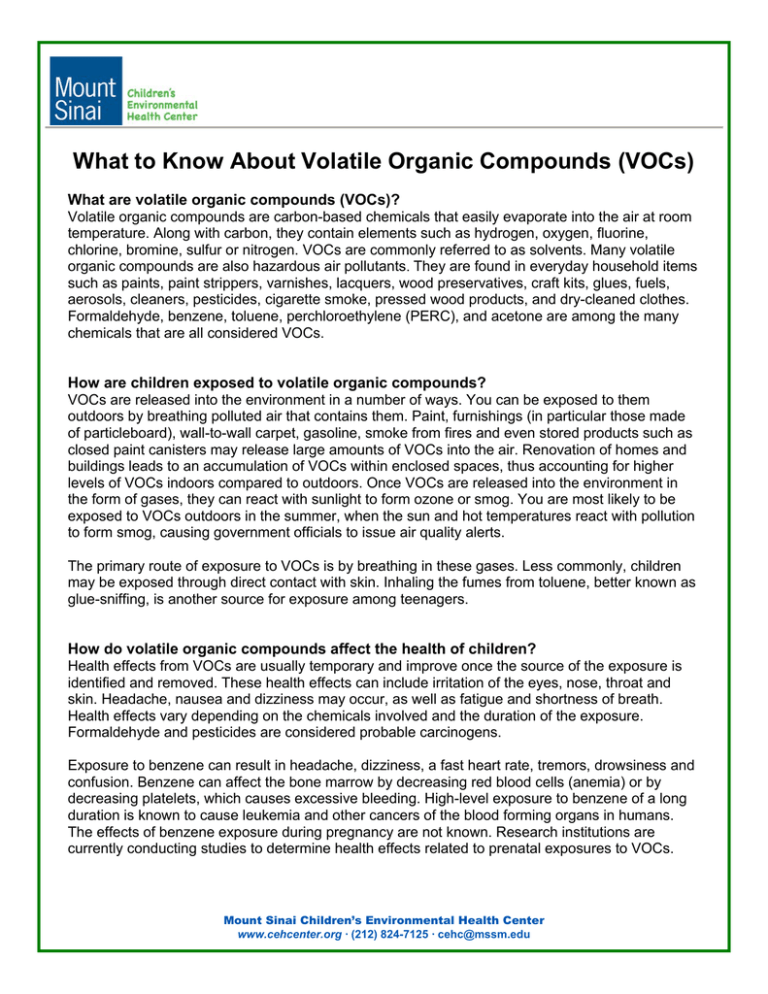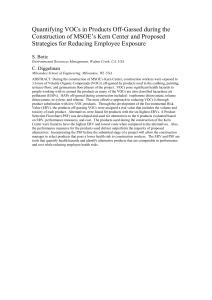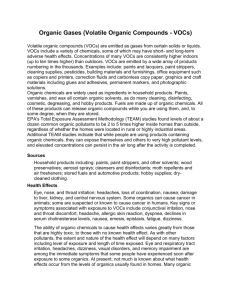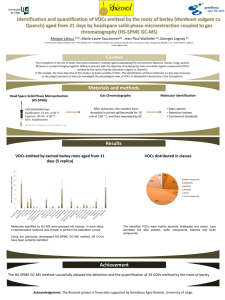Volatile Organic Compounds Fact Sheet
advertisement

What to Know About Volatile Organic Compounds (VOCs) What are volatile organic compounds (VOCs)? Volatile organic compounds are carbon-based chemicals that easily evaporate into the air at room temperature. Along with carbon, they contain elements such as hydrogen, oxygen, fluorine, chlorine, bromine, sulfur or nitrogen. VOCs are commonly referred to as solvents. Many volatile organic compounds are also hazardous air pollutants. They are found in everyday household items such as paints, paint strippers, varnishes, lacquers, wood preservatives, craft kits, glues, fuels, aerosols, cleaners, pesticides, cigarette smoke, pressed wood products, and dry-cleaned clothes. Formaldehyde, benzene, toluene, perchloroethylene (PERC), and acetone are among the many chemicals that are all considered VOCs. How are children exposed to volatile organic compounds? VOCs are released into the environment in a number of ways. You can be exposed to them outdoors by breathing polluted air that contains them. Paint, furnishings (in particular those made of particleboard), wall-to-wall carpet, gasoline, smoke from fires and even stored products such as closed paint canisters may release large amounts of VOCs into the air. Renovation of homes and buildings leads to an accumulation of VOCs within enclosed spaces, thus accounting for higher levels of VOCs indoors compared to outdoors. Once VOCs are released into the environment in the form of gases, they can react with sunlight to form ozone or smog. You are most likely to be exposed to VOCs outdoors in the summer, when the sun and hot temperatures react with pollution to form smog, causing government officials to issue air quality alerts. The primary route of exposure to VOCs is by breathing in these gases. Less commonly, children may be exposed through direct contact with skin. Inhaling the fumes from toluene, better known as glue-sniffing, is another source for exposure among teenagers. How do volatile organic compounds affect the health of children? Health effects from VOCs are usually temporary and improve once the source of the exposure is identified and removed. These health effects can include irritation of the eyes, nose, throat and skin. Headache, nausea and dizziness may occur, as well as fatigue and shortness of breath. Health effects vary depending on the chemicals involved and the duration of the exposure. Formaldehyde and pesticides are considered probable carcinogens. Exposure to benzene can result in headache, dizziness, a fast heart rate, tremors, drowsiness and confusion. Benzene can affect the bone marrow by decreasing red blood cells (anemia) or by decreasing platelets, which causes excessive bleeding. High-level exposure to benzene of a long duration is known to cause leukemia and other cancers of the blood forming organs in humans. The effects of benzene exposure during pregnancy are not known. Research institutions are currently conducting studies to determine health effects related to prenatal exposures to VOCs. Mount Sinai Children’s Environmental Health Center www.cehcenter.org · (212) 824-7125 · cehc@mssm.edu How do we test for exposure to volatile organic compounds? We do not recommend routine biological testing to check for the presence of VOCs in your child. Your child’s Pediatrician can assess if risk factors are present for VOC exposure by taking an environmental history and performing a complete physical. How do we treat volatile organic compound toxicity? The mainstay of treatment is to remove the source of the exposure. You can increase your home’s ventilation by opening windows and doors and using fans to increase air circulation. Fumes may remain for longer periods of time if the room is very humid. Keeping the humidity in your home between 30-50% will help improve the indoor air quality of your home. Once removed, symptoms will improve with time. If your child exhibits signs of wheezing or shortness of breath, he/she should be seen by a physician to determine if allergy or asthma medications are needed. How do we prevent further exposure? The following may help you reduce your child’s exposure to VOCs: • Increase ventilation by opening doors and windows in your home when using products that may release VOCs such as paints and glues. • Try not to store canisters of paint or similar products in your home that may release VOCs. Even closed containers can release gases into your home. • Follow directions when using any consumer products. They will advise you about the working conditions needed to reduce exposure to VOCs. • Keep products containing VOCs out of reach of children. • Ask your retailer about paints, furniture, and carpets that are considered “low VOC.” Products are now available that have low amounts of VOCs. • If furniture varnishes or lacquers are causing irritation, consider coating the furniture with a non-toxic sealant like polyurethane. This will help decrease the amount of gases released from the furniture. Where can I get more information? To speak with an environmental health professional in our clinical center at Mount Sinai, please call 1- 866-265-6201 or email pehsu@mountsinai.org. You may also contact your local health or environmental department or regional EPA office. Mount Sinai Children’s Environmental Health Center www.cehcenter.org · (212) 824-7125 · cehc@mssm.edu



